I always wanted to know more ... read
introduction
2 7 Y E A R S O F I B M R I S C
1965 IBM ACS
In the 1960's IBM was behind in the scientific area and
wanted to design an advanced machine better than the CDC 6800, later called the
CDC 7600.
The idea for the ACS (IBM Advanced Computing Systems) design started in 1965 with John Cocke's vision of a scientific
supercomputer. This was several years earlier than the RISC work at Berkeley and
Stanford Universities. The ACS project (which evolved from "Project Y", that
started late 1963) was cancelled in 1968.
Many of the innovative CPU organization techniques pioneered in ACS were used in the IBM
RS/6000.
After ACS, John Cocke carried this understanding of compilers and instruction sets
with him to the IBM 801 project. John also greatly influenced the IBM Cheetah and
America projects, which were the predecessors to the RS/6000.
Links:
A
Secret 1960's Supercomputer Project
IBM’s ACS-1 Machine
Technical Description of IBM ACS Project |
|
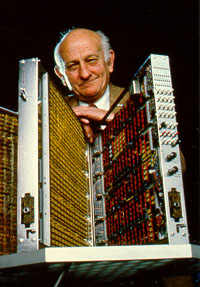 |
The
A.M. Turing Award
1987: John Cocke for significant
contributions in the design and theory of compilers, the architecture of
large systems and the development of reduced instruction set computers
(RISC); for discovering and systematizing many fundamental transformations
now used in optimizing compilers including reduction of operator strength,
elimination of common subexpressions, register allocation, constant
propagation, and dead code elimination. |
|
1974 the 801
IBM Reduced Instruction Set Computer
(RISC) technology
originated in 1974 in a project at the Thomas J. Watson Research Center to
design a large telephone-switching network. The computer needed was named the
801 (after Building 801, where the research was taking place).
The goal of the 801 was to execute one instruction per cycle. The experimental
801 was never build, but
the design, mostly developed by IBM researcher John Cocke, seemed to be an good
basis for a general-purpose, high-performance miniprocessor.
Links:
The
evolution of RISC technology at IBM (PDF)
1985 America
Based on the experimental design of the
801 and ACS ideas the
development laboratory in Austin completed a first prototype, where it
evolved into the superscalar (Instructions are handled paralel) RISC System/6000 (RS/6000) processor that was introduced into the market in
1990. Development work had been done under code name
"America" for the RISC chip research, and "RIOS" for systems
using the America technology.
1986 RT PC
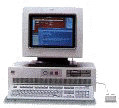 The IBM RT PC is IBM's first RISC based UNIX
(Advanced Interactive Executive [AIX] V1) computer with 32 bits ROMP processor (without
floating point capability ...) that was first announced by IBM in January
1986. The IBM RT has had a varied life from its initial announcement. The RT was
considered as "not enough power, too high a price,
and too late" and thought to be part of IBM's Personal Computer
line ... (hence RT PC, later renamed to RT).
The IBM RT PC is IBM's first RISC based UNIX
(Advanced Interactive Executive [AIX] V1) computer with 32 bits ROMP processor (without
floating point capability ...) that was first announced by IBM in January
1986. The IBM RT has had a varied life from its initial announcement. The RT was
considered as "not enough power, too high a price,
and too late" and thought to be part of IBM's Personal Computer
line ... (hence RT PC, later renamed to RT).
Links:
6150 RT PC Models 020, 025, and A25 IBM 6151 RT PC model 010
RT PC FAQ
1986 Advanced Interactive Executive
AIX for the RT PC is announced.
The RT used the Virtual Resource Manager (VRM) that provided a virtual machine environment for
the kernel, allowing more than one operating system to execute.
Links:
RT PC AIX and Virtual Resource Manager
RT PC AIX Version 2.1
1987 AIX (PS/2)
IBM will provide the PS/2 AIX Operating
System as a subset of the multiuser, multitasking, virtual memory AIX operating
system currently available on the IBM RT PC.
Links:
PS/2 AIX Statement of Direction
Availability
of PS/2 AIX delayed ...
1990 POWER
Februari 1990 IBM announces its new RISC-based computer line, the
RISC System/6000 (later named RS/6000, nowadays eServer pSeries), running AIX
Version 3. The architecture of the systems is given the name POWER (now commonly referred to as
POWER1), standing for Performance Optimization With Enhanced RISC. They where based on a multiple chip implementation of
the 32-bit POWER architecture. The models introduced included an 8 KB instruction cache
(I-cache) and either a 32 KB or 64 KB data cache (D-cache). They had a single
floating-point unit capable of issuing one compound floating-point multiply-add
(FMA) operation each cycle, with a latency of only two cycles and optimized 3-D graphics
capabilities.
The model 7013-540
(30 MHz) processed 30 million instructions per
second.
Its electronic logic circuitry had up to 800,000 transistors per silicon chip.
The maximum memory
size was 256 Mbytes and its internal disk storage capacity was 2.5 GBytes.
Links:
RISC
System/6000 POWERstations/POWERservers 520 AND 530
RISC System/6000 POWERserver 540
RISC System/6000 POWERstation 730
RISC System/6000 POWERserver 930
AIX Version 3
AIX Version 3 is announced.
Links:
AIX Version 3 (Februari, 1990)
Overview: IBM RISC System/6000 and related announcements
1992 RSC
In January of 1992, the model 7011-220
(33 MHz)  ,
an entry-level desktop workstation, was announced, based on a single chip
implementation of the POWER architecture, usually referred to as RISC Single
Chip (RSC). I recall we used to say "the pizza box".
,
an entry-level desktop workstation, was announced, based on a single chip
implementation of the POWER architecture, usually referred to as RISC Single
Chip (RSC). I recall we used to say "the pizza box".
Links:
RISC
System/6000 POWERstation/POWERserver 220, 22W AND 22G
1993 SP
 The IBM Scalable POWERparallel Systems (SP,
now commonly referred to as SP1)
offer a scalable platform for both serial and parallel applications. Based on
RISC System/6000 technology, the basic component of the in Februari 1993
announced 9076
SP1 is a system frame containing eight to 16 RISC System/6000 processor
nodes (max. four frames, 64 nodes).
The IBM Scalable POWERparallel Systems (SP,
now commonly referred to as SP1)
offer a scalable platform for both serial and parallel applications. Based on
RISC System/6000 technology, the basic component of the in Februari 1993
announced 9076
SP1 is a system frame containing eight to 16 RISC System/6000 processor
nodes (max. four frames, 64 nodes).
The SP implements Massively Parallel Processing (MPP). All the processing nodes
have their own resources (processors, memory, disks and operating system): the
shared nothing architecture.
Links:
AIX
Parallel Environment
SP models 001, 002, 003, 004, A01, AND 101
More
SP models
2001 SP
Overview
PowerPC 601
The RISC System/6000 model 7011-250 (66 MHz) workstation, the first to be based on the
32-bit PowerPC 601
processor, was introduced in September 1993.
The 601 was the
first processor arising out of a partnership between IBM, Motorola, and Apple.
From IBM, the RISC Single Chip (RSC) microprocessor became the base design for
601. The superscalar machine organization of the 601 was improved to achieve greater
performance and additional custom circuit design was applied to reduce the die size
and to allow higher frequency operation. The Motorola 88110 microprocessor bus
interface formed the basis of the development of the 601 bus interface.
The 601 did not implement
the full PowerPC instruction set (some infrequently used instruction where
excluded) and some new instructions and features were added, such as support
for symmetric multiprocessor (SMP) systems. The 601 is capable of dispatching,
executing, and completing up to 3 instructions per cycle. Instructions issue to multiple execution
units (an integer unit, a
branch processing unit, and a floating-point unit), execute in parallel, and can complete out of
order.
An SMP has multiple processors that have their own cache, the memory and devices
are shared.
The 601 was a bridge from POWER to the full
PowerPC architecture, such as the 603,
604, and 604e.
Links:
POWERstation/POWERserver 250 Series
PowerPC 601 Microprocessor
PowerPC Architecture
POWER2
 The model 7013-590
(66 MHz) was announced in September 1993 and was the first RS/6000 based on the
32-bit POWER2
architecture. The
most significant improvement introduced with the POWER2 architecture for
scientific and technical applications is that the floating-point unit (FPU)
contains two 64-bit execution units, so that two floating-point multiply-add
instructions may be executed each cycle. A second fixed-point execution unit is
also provided. In addition, several new hardware instructions were introduced
with POWER2: quad-word storage instructions, hardware square root instruction
and floating-point to integer conversion instructions.
The model 7013-590
(66 MHz) was announced in September 1993 and was the first RS/6000 based on the
32-bit POWER2
architecture. The
most significant improvement introduced with the POWER2 architecture for
scientific and technical applications is that the floating-point unit (FPU)
contains two 64-bit execution units, so that two floating-point multiply-add
instructions may be executed each cycle. A second fixed-point execution unit is
also provided. In addition, several new hardware instructions were introduced
with POWER2: quad-word storage instructions, hardware square root instruction
and floating-point to integer conversion instructions.
Initial models: 7013-58H (55 MHz),
7013-590 (66 MHz),
7015-990 (71.5 MHz).
Links:
POWER2: Next Generation of the RS/6000 Family
PowerPC
and POWER2: Technical Aspects of the New IBM RS/6000
POWER2
Architecture Implementations
POWER2
and PowerPC architecture
Migration and Compatibility
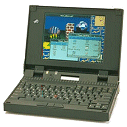 1994
Notebook
1994
Notebook
The RS/6000 7007-N40 (50 MHz) notebook workstation
(introduced in March) is the ideal portable companion for mobile professionals
who want to take AIX on the road. Based on the PowerPC 601.
Links:
7007-N40
IBM RS/6000 Model N40
SP2
The Scalable POWERparallel Systems 2 (SP2) was announced in April 1994. Based on IBM's
RISC System/6000 microprocessor technology and running AIX/6000 (as it was named
then), the SP2 could scale from
two to 128 nodes (processing elements). Using a POWER2 processor and other
options it performed twice
the processing power of the SP1 system.
Links:
Scalable
POWERparallel Systems 9076 SP2 and Enhancements for SP1
Scalable Parallel Computing
9076-xxx SP Family
AIX Version 4.1
AIX Version 4.1 is announced.
Links:
AIX
Version 4.1 (July, 1994)
AIX
Version 4 Overview and Product Life Cycle Dates
AIX Version 4.2 Overview and Product Life Cycle Dates
AIX Version 4.3 Overview and Product Life Cycle Dates
1995 PowerPC 604
32-bit PowerPC
604 RISC System/6000 microprocessor (120
MHz) upgrade announced for the RISC System/6000 model 7020-40P
(66 MHz).
Links:
Motorola/IBM
PowerPC 604/604e
 1996 POWER2 Super Chip
1996 POWER2 Super Chip
October 1996 the
RS/6000 model 7013-595
(135 MHz) was announced with the new 32-bit POWER2 Super Chip (also known as P2SC). The P2SC is a single chip
implementation of the POWER2 architecture, containing 15 million transistors on a single chip. It powers the wide and thin
nodes in SP systems.
Links:
SP
POWER2 Super Chip Nodes
RS/6000
In October (?) IBM renames RISC System/6000:
RS/6000.

PowerPC 603e
October 1996, announcement of the
portable workstation RS/6000
model 860 (166 MHz) - notebook - using the 32-bit PowerPC 603e processor.
PowerPC 604e
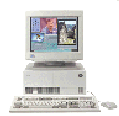 The
43P
models 140 and 240 with 32-bit
PowerPC
604e RS/6000 microprocessor (166 MHz)
are announced. The 604e is a superscalar processor capable of issuing four
instructions simultaneously. As many as seven instructions can finish execution
in parallel.
The
43P
models 140 and 240 with 32-bit
PowerPC
604e RS/6000 microprocessor (166 MHz)
are announced. The 604e is a superscalar processor capable of issuing four
instructions simultaneously. As many as seven instructions can finish execution
in parallel.
Links:
PowerPC
604e Overview
PowerPC
604e Technical Library
1997 RS64
 The RS64 (also known as Apache) is the
first 64-bit PowerPC RISC processor (October
1997).
The RS64 is a superscalar processor optimized for commercial workloads. The processor has separate 64 KB L1 cache for instructions and
data and L2 cache controllers. The L2 caches run at full processor speed.
The RS64 contains a 16 byte interface to 2-way set associative 4MB L2 cache. The
RS64 is also used in the AS/400 (called A35). Predecessors of the A35, only
running OS/400 are the A10 (a.k.a. Cobra), the world's first 64-bit PowerPC
microprocessor, and A25 (a.k.a. Muskie).
The RS64 (also known as Apache) is the
first 64-bit PowerPC RISC processor (October
1997).
The RS64 is a superscalar processor optimized for commercial workloads. The processor has separate 64 KB L1 cache for instructions and
data and L2 cache controllers. The L2 caches run at full processor speed.
The RS64 contains a 16 byte interface to 2-way set associative 4MB L2 cache. The
RS64 is also used in the AS/400 (called A35). Predecessors of the A35, only
running OS/400 are the A10 (a.k.a. Cobra), the world's first 64-bit PowerPC
microprocessor, and A25 (a.k.a. Muskie).
IBM brings 64-bit technology to the market introducing the RS/6000 Enterprise
Server model 7017-S70
(125 MHz, code named Raven), the first 12-way SMP system, and AIX Version 4.3.
Links:
The 64-bit solution
RS/6000
Enterprise Server Model S70 Blazes the 64-Bit Trail
AIX Version 4.3
AIX Version 4.3 is announced. 32-bit/64-bit
application coexistence and concurrent execution. The kernel is still 32 bits.
Links:
AIX
Version 4.3 (October 1997)
AIX
Version 4.3.1 (April 1998)
AIX
Version 4.3.2 (October 1998)
1998 RS64 II
PowerPC RS64 II 64-bit RISC microprocessor (also know as NorthStar) is the first
in the Star series processor family.
The in July 1998 announced RS64-II contains a dedicated 32 byte interface to a private 4-way set
associative 8MB L2 cache. The processor target operating frequency is 262 MHz.
The 262 MHz cards contain four processors per card. Up to three 4-way cards can
be installed in a RS/6000 7017-S70
to create a 4-way, 8-way, or 12-way system.
Links:
The
RS/6000 Enterprise Server Model S70
4th
Generation 64-bit PowerPC-Compatible Commercial Processor Design
New Processors Enhance the IBM RS/6000 Model S70 Performance
POWER3
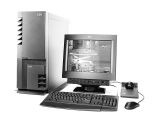 The new 64-bit POWER3 processor, announced October 1998, unifies the POWER2 architecture (P2SC) with the PowerPC architecture.
The new 64-bit POWER3 processor, announced October 1998, unifies the POWER2 architecture (P2SC) with the PowerPC architecture.
The SMP-capable POWER3 design
allows for concurrent operation of fixed-point instructions, load/store
instructions, branch instructions, and floating-point instructions. The POWER3
is capable of executing up to four floating-point operations per cycle (two
multiply-add instructions). Integer performance has been significantly enhanced over the
P2SC with the addition of dedicated integer and load/store execution units. The chip
features eight execution units fed by a 6.4 gigabyte-per-second memory
subsystem. The core includes two high-bandwidth buses: a 128-bit 6XX
architecture bus to main memory and 256-bit bus to the L2 cache that runs at
processor speed. The POWER3 also has on-chip 64KB data cache and a 32KB
instruction cache.
IBM's first 64-bit symmetric
multiprocessor (SMP) workstation is the POWER3 based RS/6000 43P 7043-260
(200 MHz).
Links:
RS/6000
43P 7043 Model 260
POWER3:
The next generation of PowerPC processors
POWER3: Next generation 64-bit PowerPC Processor Design (PDF)
New
IBM POWER3 chip
The
POWER3 Microarchitecture
Overview
of Recent Supercomputers
History
of POWER processors
Characterization of Web Server Workloads on Three Generations of IBM PowerPC
Microarchitectures (PDF)
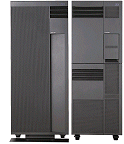 1999
RS64 III
1999
RS64 III
PowerPC RS64 III 64-bit
RISC microprocessor (also known as Pulsar) using copper technology. The RS64 III
microprocessor powers the in September 1999 announced RS/6000 model 7017-S80
(450 MHz). The frequency of 450 MHz was
accomplished by using IBM's new copper technology (CMOS 7S). The RS64 III has 8
MB of Level 2 (L2) cache per processor. The 6-way SMP can be expanded to a
24-way SMP and the system memory can be expanded to 96 GB.
Links:
5th
Generation 64-bit PowerPC-Compatible Commercial Processor Design
Custom
circuit design as a driver of microprocessor performance
AIX Version 4.3.3
AIX Version 4.3.3 is announced.
links:
AIX
Version 4.3.x Overview and Product Life Cycle Dates
AIX
Version 4.3.3 UNIX Operating System ( September 1999)
2000 POWER3-II
 The
64-bit POWER3-II microprocessor design is based on IBM's
advanced CMOS 7S process, which is a re-implementation of POWER3
using copper interconnects. The
64-bit POWER3-II microprocessor design is based on IBM's
advanced CMOS 7S process, which is a re-implementation of POWER3
using copper interconnects.
New RS/6000 model 44P 7044-270
(375 MHz) using the 1-4 way SMP with POWER3-II copper-based
microprocessor.
The POWER3-III didn't surface, so POWER4 is the next ...
Links:
Power3-II
375/450 MHz Processors
RS/6000
44P 7044 Model 270
Why
copper?
Back
to the Future: Copper Comes of Age
|
|
| The
use copper "wiring" for integrated circuits in 1997 was a
breakthrough in semiconductor technology (smaller, faster, more
powerful and less costly). The first copper chip was a PowerPC for
Apple iMac systems (September 1998). |
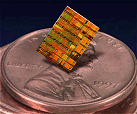 |
|
eServer pSeries
I n October IBM renames RS/6000: eServer pSeries.
n October IBM renames RS/6000: eServer pSeries.
Links:
IBM
introduces servers for the next generation of e-business
A Server By Any Other
Name
RS64 IV
PowerPC RS64 IV 64-bit
RISC microprocessor (also known as Sstar) using copper and SOI technology.
The in October 2000 announced pSeries
680 (600 MHz) a is 6- to 24-way 64-bit SMP server with up to 96GB of system
memory and 16MB L2 cache for each 600 MHz processor.
Links:
A
multithreaded PowerPC processor for commercial servers
 |
Silicon-on-insulator (
SOI) technology improves
performance over bulk CMOS technology by up to 35% and reduces power requirements by up to
66%. SOI refers to placing
a thin layer of silicon on top of an
insulator such as silicon oxide or glass. The transistors would then be built on
top of this thin layer of SOI. The basic idea
is that the SOI layer will reduce the capacitance (the ability of a structure to
store electrical charge) of the switch, so it will operate faster.
SOI protects the millions transistors on a chip with a blanket of insulation,
reducing harmful electrical effects that consume energy and hinder performance.
The first SOI/copper-based chip was shipped in May 1999 (a PowerPC processor
used in new AS/400 models). |
 AIX 5L Version 5.1
AIX 5L Version 5.1
AIX 5L Version 5.1 is announced in April. Full 64-bit kernel,
device drivers, and application environment, and Linux affinity. AIX 5.1 also
supports 32-bit POWER architecture and Intel Itanium (on a limited basis)
architecture.
Links:
AIX 5L
AIX
5L Version 5.1
Monterey
- AIX on Itanium ?
SP2
Overview
The RS/6000 SP system hosts dozens to hundreds
of RISC processor nodes facilitating parallel processing capability.
The basic SP building block is the processor node. It consists of a POWER3
or PowerPC Symmetric Multiprocessors (SMP), memory, Peripheral Component
Interconnect (PCI) expansion slots for Input/Output (I/O) and
connectivity, and disk devices. Nodes have either a Symmetric
MultiProcessor (SMP) configuration (using PCI) or a uniprocessor
configuration (using MCA). The three types of nodes (thin, wide, and high)
may be mixed in a system and are housed in short or tall system frames.
Depending on the type of nodes used, an SP tall frame can contain up to 16
nodes and an SP short frame can contain up to 8 nodes. These frames can be
interconnected to form a system with up to 128 nodes (512 by special
order). Each node contains its own copy of the AIX operating system.
Links:
RS/6000
SP and Clustered IBM eServer pSeries Systems Handbook
RS/6000
SP Processors
Advanced Computer
Technology Center (ACTC)
RS/6000
SP Resource Center
RS/6000
SP Planning Volume 1, Hardware and Physical Environment |
 The
currently used 222 MHz/375 MHz POWER3 SMP nodes, are powered by the
same POWER3 processor technology introduced with the RS/6000 43P
model 260/270 workstation.The 332 MHz SMP nodes are powered by the
PowerPC 604e processor. Earlier nodes used POWER1 (62 MHz), POWER2
(66/77 MHz), PowerPC 604 (112/200 MHz) and P2SC (120/135/160 MHz)
and POWER3 (200 MHz). The
currently used 222 MHz/375 MHz POWER3 SMP nodes, are powered by the
same POWER3 processor technology introduced with the RS/6000 43P
model 260/270 workstation.The 332 MHz SMP nodes are powered by the
PowerPC 604e processor. Earlier nodes used POWER1 (62 MHz), POWER2
(66/77 MHz), PowerPC 604 (112/200 MHz) and P2SC (120/135/160 MHz)
and POWER3 (200 MHz). |
|
Photos: Courtesy of International Business
Machines Corporation. Unauthorized use not permitted.

 The
The  The IBM Scalable POWERparallel Systems (SP,
now commonly referred to as SP1)
offer a scalable platform for both serial and parallel applications. Based on
RISC System/6000 technology, the basic component of the in Februari 1993
announced
The IBM Scalable POWERparallel Systems (SP,
now commonly referred to as SP1)
offer a scalable platform for both serial and parallel applications. Based on
RISC System/6000 technology, the basic component of the in Februari 1993
announced  The model
The model  1994
Notebook
1994
Notebook

 The
The
 The RS64 (also known as Apache) is the
first 64-bit PowerPC RISC processor (October
1997).
The RS64 is a superscalar processor optimized for commercial workloads. The processor has separate 64 KB L1 cache for instructions and
data and L2 cache controllers. The L2 caches run at full processor speed.
The RS64 contains a 16 byte interface to 2-way set associative 4MB L2 cache. The
RS64 is also used in the AS/400 (called A35). Predecessors of the A35, only
running OS/400 are the A10 (a.k.a. Cobra), the world's first 64-bit PowerPC
microprocessor, and A25 (a.k.a. Muskie).
The RS64 (also known as Apache) is the
first 64-bit PowerPC RISC processor (October
1997).
The RS64 is a superscalar processor optimized for commercial workloads. The processor has separate 64 KB L1 cache for instructions and
data and L2 cache controllers. The L2 caches run at full processor speed.
The RS64 contains a 16 byte interface to 2-way set associative 4MB L2 cache. The
RS64 is also used in the AS/400 (called A35). Predecessors of the A35, only
running OS/400 are the A10 (a.k.a. Cobra), the world's first 64-bit PowerPC
microprocessor, and A25 (a.k.a. Muskie). The new 64-bit POWER3 processor, announced October 1998, unifies the POWER2 architecture (P2SC) with the PowerPC architecture.
The new 64-bit POWER3 processor, announced October 1998, unifies the POWER2 architecture (P2SC) with the PowerPC architecture.
 The
64-bit POWER3-II microprocessor design is based on IBM's
advanced CMOS 7S process, which is a re-implementation of POWER3
using copper interconnects.
The
64-bit POWER3-II microprocessor design is based on IBM's
advanced CMOS 7S process, which is a re-implementation of POWER3
using copper interconnects.
 n October IBM renames RS/6000: eServer pSeries.
n October IBM renames RS/6000: eServer pSeries.
 The POWER4 "Gigaprocessor" copper SOI 64-bit CMP microprocessor is based
on all earlier designs.
The POWER4 "Gigaprocessor" copper SOI 64-bit CMP microprocessor is based
on all earlier designs.  The in October
introduced 8- to 32-way 64 bit SMP server
The in October
introduced 8- to 32-way 64 bit SMP server 
 The
currently used 222 MHz/375 MHz POWER3 SMP nodes, are powered by the
same POWER3 processor technology introduced with the RS/6000 43P
model 260/270 workstation.The 332 MHz SMP nodes are powered by the
PowerPC 604e processor. Earlier nodes used POWER1 (62 MHz), POWER2
(66/77 MHz), PowerPC 604 (112/200 MHz) and P2SC (120/135/160 MHz)
and POWER3 (200 MHz).
The
currently used 222 MHz/375 MHz POWER3 SMP nodes, are powered by the
same POWER3 processor technology introduced with the RS/6000 43P
model 260/270 workstation.The 332 MHz SMP nodes are powered by the
PowerPC 604e processor. Earlier nodes used POWER1 (62 MHz), POWER2
(66/77 MHz), PowerPC 604 (112/200 MHz) and P2SC (120/135/160 MHz)
and POWER3 (200 MHz).